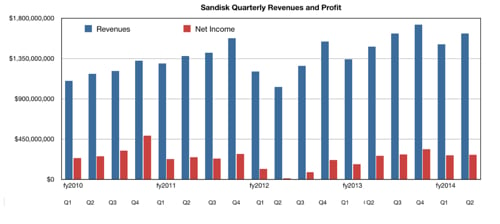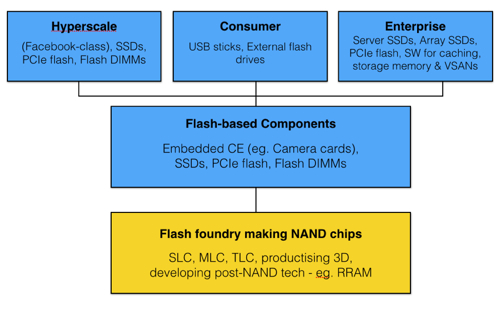Original URL: https://www.theregister.com/2014/08/04/sandisk_set_for_flash_stardom/
Is SanDisk about to become the big daddy of enterprise flash?
El Reg takes a detailed look at runners and riders for the storage crown
Posted in Storage, 4th August 2014 12:33 GMT
Comment The hottest enterprise flash products company these days is SanDisk, and it has a great chance of becoming the most important non-volatile memory supplier of all – the EMC of enterprise flash.
There are four basic reasons:
- It has a thriving and growing enterprise flash business
- It has bought Fusion-io in May giving it a growing PCIe flash card hardware and software business
- It partners Toshiba in the flash foundry business, giving flash chip supply surety
- It has more vertical integration up into the flash product stack than any other flash foundry operator, for example, buying the Plaint controller business in 2011
SanDisk boss Sanjay Mehrotra said in July that SanDisk's second quarter revenues were a record “in both enterprise and client SSDs, as well as retail products … Our results position us well to deliver another record year in 2014.”
SanDisk SanDisk bought SMART Storage and its FlashDIMM technology in June last year, which is looking like a very smart (sorry) buy. Flash DIMMS put flash even closer to a server's CPU than PCIe flash, lowering data access latency.
A fifth reason is that none of its competitors are currently equipped to catch it. A tremendous amount of consolidation has taken place in the flash hardware (SSDs and PCIe) and software space in the past 24 months. Even so, SanDisk's competitors are not well enough equipped in terms of technology, focus, channels and market footprint to match SanDisk in its capabilities and prospects.
They consist of:
- Intel
- Micron
- Samsung
- Seagate
- SK Hynix
- Toshiba
- WD's HGST
Why, in my view, are these competitors in a worse position than SanDisk?
Intel
Intel is a massive CPU-dominated business, which also has a line of SSD and PCIe flash products. It is capitalised at $167bn and has a partnership with Micron in Intel Micron Flash Technologies (IMFT). This is currently producing 20nm NAND chips.
After a rocky start Intel now has a solid range of SSDs, including data centre and notebook products - like the Pro 2500, and has HGST as an OEM for some of its enterprise SSD technology.
The company also has a line of P3000 PCIe flash cards using the NVMe interface standard, with up to 2TB of capacity.
Our impression is that Intel has little desire to progress any further up the flash stack. being content to be a chip, PCIe and SSD flash component supplier. We think it should get stuck into flash DIMMs, engineering its own technology if licensing Diablo's is not to its taste.
Compared to its x86 and other CPU business, flash is pretty much a small proportion of Intel's revenues and we haven't heard of any 3D NAND initiatives from the company, nor of anything like SanDisk's 15nm NAND. This suggests that Intel is, to some extent, coasting along rather than driving the technology.
Micron
Micron, capitalised at $33.6bn, makes DRAM and NAND chips, being second to Samsung we understand as a NAND chip supplier. It builds a solid line of SSDs and PCIe flash products using these NAND chips. but has, we understand, little real interest in expanding out from these two component areas.
The acquisition and integration of Elpida in its DRAM business will have obviously taken a huge amount of effort.
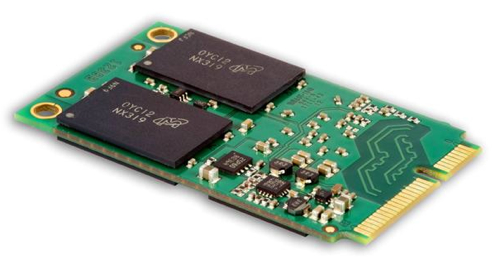
Micron C400 mSATA SSDE
Although Micron is a huge and determined flash player, at the foundry, PCIe and SSD levels there appears to be little appetite for getting PCIe flash software or storage memory capabilities. Hardware components rule and software and cramming components into finished systems are both someone else's business.
Can this strategy safeguard Micron if, as we suspect, vertical integration is going to become a stronger and stronger trend? We think not and see partnerships or relationships of some kinds coming in the future to ensure Micron has a presence higher up the flash stack.
Samsung
Samsung is the leading NAND chip supplier in the industry, and is part of the massive Korean electronics. Its capitalisation is $162.4bn (169.17tn won) and it produces lots and lots of SSDs plus having a couple of XP PCIe flash card products in its locker as well.
It's fair to say that SSDs dominate the flash components it ships with a minor PCIe market presence. A lot of its output will go into its own smartphones.
There is little evidence that Samsung wants to move up the flash stack, being content, it appears to knock out lots of chips and lots of SSDs.
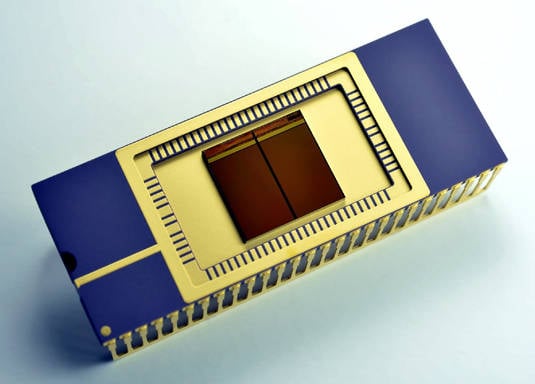
Samsung 3D vertical NAND
However, Samsung's PCIE product line and market presence is weak and it surely needs to strengthen that product line or it could be forced out of the PCIe flash card market.
If there is enough supplier consolidation at the flash components levels then Samsung may need to integrate upwards in order to give itself a channel to market. If it feels that need then it could partner with Seagate with whom it has SSD development arrangements.
Our take is that so far, Samsung sees no need to do this.
Seagate
This Steve Luczo-led company, capitalised at $19.8bn, is the world's number two disk drive manufacturer with a presence in consumer storage products - external, mobile and desktop storage - and low-end NAS arrays as well as online backup with its EVault service. It has a line of Pulsar-branded SSDs which haven't seen much success.
The company bought Samsung's hard disk drive business and has Samsung representation on its board, paving the way for a flash foundry supply relationship. In fact such a relationship may already exist.
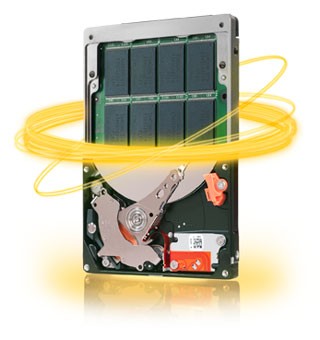
Seagate Momentus XT hybrid disk drive
It also has an investment, made in June 2012, in Densbits, a NAND storage controller IP company with endurance extension software. The two agreed a strategic agreement for the development of low-cost, high-performance Solid State Drives (“SSD”) for the consumer and enterprise markets. Densbits has subsequently licensed its so-called Memory Modem technology to Toshiba. Seagate also invested in PCIe flash card supplier Virident only to see WD buy the company.
As a vertically integrated hard disk drive supplier Seagate needs no convincing of the virtues of vertical integration.
Culturally Seagate is a spinning disk company with more than 90 per cent of its revenues dependent on disks. It knows that flash provides much faster data access than disk and has tried with four generations if product to build flash-cached disk drives - hybrid drives - as a way of bridging flash speed and disk capacity. It is not clear that these products are, so to speak, setting the world on fire though.
Its line of Pulsar SSDs are similarly in a kind of halfway house: present in the market but not setting it on fire.
However things are changing. PCIe flash-wise Seagate was up until May this year when it bought the LSI Nytro PCIe flash card business from Avago in May. LSI has been saying it's the number 2 PCIe flash card shipper to enterprises, and brings an Oracle Exadata supply deal to Seagate.
The purchase also included the SandForce controller business supplying SSD controllers to SSD manufacturers and giving Seagate in-house SSD controller IP.
Overall Seagate up until May was a me-too SSD supplier with unexceptional SSD technology and a technology follower only too aware of not wanting to cannibalise its disk drive business. Now though it has a solid PCI flash card line which could carry on being a major player given the right focus, and its own controller IP.
Two missing pieces are SSD and PCIe flash software for caching and storage memory, and a NAND chip supply deal. In our view the basis for this is in place with Samsung and, were Seagate and Samsung to do a flash chip supply deal, then Seagate's flash future would be more assured.
It has to get a flash component software capability in our view and that will almost inevitably come, if it does come, through an acquisition.
When these two pieces are in place then Seagate could become a major enterprise flash component player and start catching up with SanDisk.
SK hynix
This Korean DRAM and flash foundry supplier produces NAND chips and bought Violin's unwanted Velocity PCIe flash card business, signalling something of a vertical integration strategy.
It also has a line of SSDs (datebook PDF).
The company says it is on course to mass produce 3D NAND by the end of the year. Previously it had a relationship with HP to being that company's memristor technology to product status for 2013 – an effort that seems to have failed.
SK hynix is the second-largest memory chip manufacturer after Samsung, and is capitalised at around $32.4bn. It would be a tough acquisition should anyone be so-minded.
From the point of view of having a vertically-integrated flash stack SK hynix is, in our view, making halting steps towards the idea and could go further but needs acquisitions or strategic relationships to do so. In our view it lags behind SanDisk in the vertically integrated flash stack stakes.
Toshiba
Japan-based electronics conglomerate Toshiba, capitalised at about $18.7bn (1.93tn yen), operates a flash foundry business in partnership with SanDisk. It builds a range of SSD products using its 24nm and 19nm NAND chips.
Toshiba ships a range of SSDs and was having Violin Memory develop a PCIe flash card product for it. That got cancelled when Violin Memory restructured itself with a new CEO.
The company bought the assets of crashed SSD startup OCZ and got itself a range of SSD intellectual property, including "Barefoot" controller technology and also a PCIe product line.
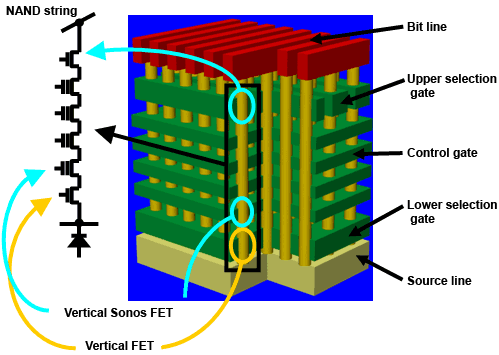
Toshiba stacked flash idea
Toshiba is not a glamorous supplier in a marketing sense, producing solid and well-specc'd products. We're expecting its PCIe product line to strengthen substantially. The company us not known for splashing out on acquisitions, the purchase of OCZ assets is pretty much a firesale, and so we can't expect it to build itself a vertically integrated flash stack through acquisitions.
We can generally view Toshiba as a focussed NAND foundry and component supplier, SSDs and PCIe flash, with no apparent interest in getting itself flash software capability. It has been the most flash-aware of the disk drive suppliers for some time, with both Seagate and WD taking their time, so to speak, before getting on board the flash train.
WD's HGST
HDD-manufacturer HGST was quite early in to SSDs, manufacturing an enterprise Ultrastar SSD line co-developed with Intel since 2008, and using Intel NAND. It has just refreshed these products with capacities rising to 1.6TB.
WD, then Western Digital, bought HGST in a prolonged process starting in March 2011. It has still not completed that deal thanks to MOFCOM, a Chinese regulator, preventing Western Digital and HGST's disk operations being integrated.
WD inherited HGST's SSD business and has energetically bulked it out with a series of acquisitions in 2013 – one of those taking place in 2009 when WD first dipped its toes into the flash technology stream:
- Military spec SSDs with the March 2009 $65m SiliconSystems acquisition
- Ultrastar enterprise SSDs with the HGST acquisition announced in 2011
- More enterprise SSDs with sTec acquisition in 2013, which also provide Kronos PCIe flash cards
- Server SSD caching software from Velobit, bought in 2013
- Server PCIe flash cards and storage memory-like software from Virident, along with its cross-server flash store data sharing software in 2013
WD also has an investment in all-flash array startup Skyera.
However, it appears that HGST SSD sales are overly concentrated in a few customers and one if them, moving from single to multi-sourcing its SSDs has depressed HGST's enterprise SSD sales, the effect being seen in the last two quarters:
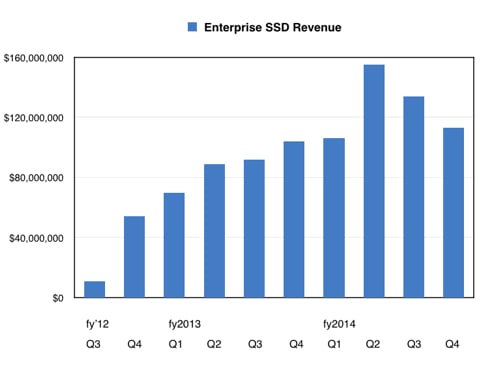
This leaves us thinking that HGST is currently not as strong as out might be in enterprise SSD sales but has a lot of technology pieces it can integrate to build out a great SSD and PCIe product roadmap.
The major concern here is NAND chip supply, with their being no known agreement between WD and a flash foundry operator.
WD is a relative minnow compared to Intel, only having a $23.4 billion market capitalisation.
Buying SanDisk
Buying SanDisk would be an immediate way for any existing or wannabee flash stack supplier to get instant market leadership. With a market capitalisation of $20.7bn the company would cost upwards of $25bn or more to buy.
That means a buyer would need to stump up around $25-30bn and there are three companies in the list we've looked that are big enough to do that: Intel with its $167bn capitalisation, Micron and Samsung.
If buying SanDisk is ruled out then another option would be for WD and SK hynix to do a deal. With WD needing a foundry and SK hynix needing a stronger presence in the flash stack components area, where WD/HGST has a nice set of pieces, there us a basic fit between them.
An off-the-wall idea would be for WD/HGST and Micron to get together, or WD/HGST and Intel – us US folks have got to stick together, right?
These ideas might also have been looked at around Seagate's executive tables. However, another seemingly natural pairing is between Seagate and Samsung with Seagate OEM'ing Samsung's NAND chips. Seagate is used to being top dog in any relationship. So too is Samsung, making for an interesting cultural clash if the two do come together.
Our view is that flash technology is going to dramatically and significantly redraw the lines of the storage component industry. We think SanDisk is in a prime condition and that foundry linkups will define whether Seagate and WD/HGST progress into becoming tier 1 vertically-integrated flash players along with SanDisk.
If neither WD nor Seagate get flash foundry linkups then their long term flash product market presence could, and probably will, be jeopardised
How Intel, Micron, Samsung and Toshiba will fare as vertical integration becomes more and more necessary is open to question. Could, for example, Toshiba build on its partnership with SanDisk by buying a stake in it? Could Intel sell its flash business to Micron? Could Samsung buy into Seagate?
Big, big questions, but the flash times they are a-changing and a hard rain's likely to fall on some players. ®
